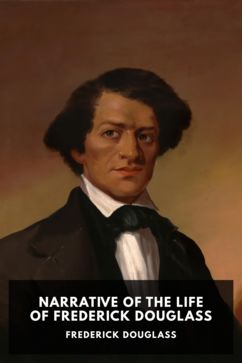Narrative of the Life of Frederick Douglass

Description
The Narrative of the Life of Frederick Douglass was written in 1845, seven years after Douglass escaped slavery, and is the first of three autobiographies. It covers his life as a slave, enduring the whips of the overseers and the hopelessness of his circumstances, until his escape to the north and arrival at New Bedford, Massachusetts. The brutalities he witnessed and his slowly growing desire for freedom are presented in the vivid language he was already known for in his antislavery oration.
The eloquence of Douglass’s speeches caused some skeptics to doubt his credibility, believing that a former slave with no education could never speak so well. Thus, part of his motivation for writing the book was to dispel this suspicion and to provide a fuller history than was possible in his lectures. The abolitionists William Lloyd Garrison and Wendell Phillips provided introductions vouching for the truth of Douglass’s words.
The book was an immediate best seller. The fame brought danger to Douglass, who sailed for England shortly after the book’s publication to ensure he would not be apprehended as a fugitive slave. He spent two years touring and lecturing in Great Britain and Ireland before returning to America to continue his abolitionist work. English supporters raised funds to purchase his freedom from his former master.
The slave narrative is an autobiographical genre written by escaped slaves concerning their lives in bondage. Slave narratives not only promoted abolitionism by giving first hand evidence of the cruelty and hypocrisy of slaveholders, but also allowed African Americans to express themselves as intelligent, articulate individuals, deserving of respect and freedom. Douglass’s Narrative is perhaps the most important example of the genre, on the basis of its literary merits and its impact on the abolitionist movement.
Read free
This ebook is thought to be free of copyright restrictions in the United States. It may still be under copyright in other countries. If you’re not located in the United States, you must check your local laws to verify that this ebook is free of copyright restrictions in the country you’re located in before accessing, downloading, or using it.

Download for ereaders
-
Compatible epub — All devices and apps except Kindles and Kobos.
-
azw3 — Kindle devices and apps. Also download the Kindle cover thumbnail to see the cover in your Kindle’s library. Despite what you’ve been told, Kindle does not natively support epub. You may also be interested in our Kindle FAQ.
-
kepub — Kobo devices and apps. You may also be interested in our Kobo FAQ.
-
Advanced epub — An advanced format that uses the latest technology not yet fully supported by most ereaders.
Read online
A brief history of this ebook
More details
Sources
Transcriptions
Page scans
Improve this ebook
Anyone can contribute to make a Standard Ebook better for everyone!
To report typos, typography errors, or other corrections, see how to report errors.
If you’re comfortable with technology and want to contribute directly, check out this ebook’s GitHub repository and our contributors section.
You can also donate to Standard Ebooks to help fund continuing improvement of this and other ebooks.